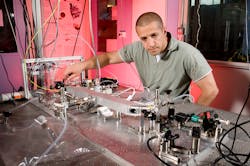SPECTROSCOPIC ANALYSIS: Laser for Mars aims to spot counterfeit foods on Earth
A laser system originally developed to investigate the prospect of past life on Mars could be on its way to proving the provenance of your olive oil. What do these two tasks have in common? They both rely on measurement of isotope ratios.
Differing amounts of carbon isotopes can give indications as to how carbon dioxide was formed on Mars. Equally, because that isotope ratio differs across Earth’s surface as well, it can give hints as to the geographic origins of a wide array of organic products.
Researchers at the Rutherford Appleton Laboratory Space (RAL Space; Didcot, England) first developed the system as part of the European Space Agency’s multidecade Aurora program of Mars landers. The plan was to use mid-infrared (mid-IR) lasers in an absorption spectrometer.
“We’re using lasers to push sensitivity to the limit,” says Damien Weidmann, RAL Space’s laser spectroscopy team leader. “The overall aim of this kind of system is to get similar performance to the ‘gold standard’—isotope ratio mass spectrometry—but in a compact and robust package so it can be deployed at the point of analysis.”
That is easier said than done. While laser-based systems open up the possibility of higher detection sensitivity, they are themselves sensitive to their environment.
“One of the usual pitfalls of laser systems for isotope-ratio analysis is sensitivity to temperature variations of the sample,” says Weidmann. “We address this with two lasers which target a specific molecular transition whose intensity changes the same way with temperature, therefore canceling the effect.”
The setup relies on a continuous-wave (CW) distributed-feedback (DFB) quantum-cascade laser emitting at 4.3 μm in conjunction with a 2.7 μm CW DFB antimonide laser diode, both of which are commercial products, notes Weidmann (see figure). The team’s design also includes a sample cell to allow real-time calibration and baseline correction of the readings, so the system maintains its accuracy in a range of conditions.
Large potential market
The European Space Agency’s Technology Transfer Programme Office, which spins off technology originally designed for space applications to a wider community, saw the potential for use of the laser-isotope ratiometer back on Earth. The organization funded a demonstration project to prove the system’s worth for agronomy applications, such as determining the origins of foodstuffs.
The idea is to use a combustion chamber to burn small amounts of a given sample, and use the ratiometer to analyze the carbon within the exhaust gases—making it possible to analyze any organic products.
“It’s believed to be the largest market for this kind of instrument,” says Weidmann. “You want to identify the geographic origin, so the main market is detecting counterfeit products. You can check their isotopic composition; that applies to products which have their added value from their geographic origin—olive oil and chocolate are good examples.”
To tackle this application, the RAL Space team has joined forces with Protium (Daresbury, England), a company established in the mass spectrometry business.
But Weidmann suggests that plenty of other applications await, from atmospheric chemistry, to the geochemistry of volcanoes, to the analysis of breath in medicine—all situations where a high-accuracy but robust and field-ready device is needed. What the effort needs first is the time and the funding to miniaturize and ruggedize the experiment.
“It’s still a first, a benched-up system,” says Weidmann. “We now need a more fully engineered system—to reduce the size, couple to a miniature combustor, to get something closer to a final product.”
